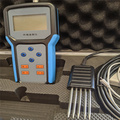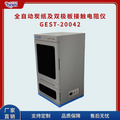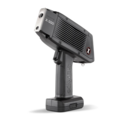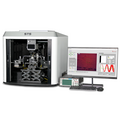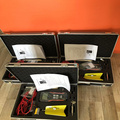基于立成分分析的密度肌电图分解算法:上肢肌肉的实验评价
ndependent component analysis based algorithms for high-density electromyogram decomposition: Experimental evaluation of upper extremity muscles
Chenyun Dai a , Xiaogang Hu a, ∗ a Joint Department of Biomedical Engineering, University of North Carolina at Chapel Hill, North Carolina State University, United States A
ABSTRACT
Motor unit firing activities can provide critical information regarding neural control of skeletal muscles. Extracting motor unit activities reliably from surface electromyogram (EMG) is still a challenge in signal processing. We quantified the performance of three different independent component analysis (ICA)-based decomposition algorithms (Infomax, FastICA and RobustICA) on high-density EMG signals, obtained from arm muscles (biceps brachii and extensor digitorum communis) at different contraction levels. The source separation outcomes were evaluated based on the degree of agreement in the discharge timings between different algorithms, and based on the number of common motor units identified concurrently by two algorithms. Two metrics, the separation index (silhouette distance or SIL) and the rate of agreement, were used to evaluate the decomposition accuracy. Our results revealed a high rate of agreement (80%–90%) between different algorithms, which was consistent across different contraction levels. The RobustICA tended to show a higher RoA with the other two algorithms (especially with Infomax), whereas FastICA and Infomax tended to yield a greater number of common MUs. Overall, through an experimental evaluation of the three algorithms, the outcomes provide information regarding the utility of these algorithms and the motor unit filter criteria involving EMG signals of upper extremity muscles.
INTRODUCTION
Electromyogram (EMG) signals represent a convoluted process of hundreds of motor unit (MU) discharge activities with the corresponding motor unit action potentials (MUAPs). Decomposition of the EMG signals involves the separation of the composite interference activities into the constituent MU discharge activities, which can provide clinical and scientific insights into the neuromuscular systems [1–4]. In addition, recent studies have shown that MU discharge timings could be used as a neural interface signal during human-machine interactions [5].Earlier EMG decomposition mainly based on template-matching of MUAPs via manual expert editing or automated algorithms using intramuscular recordings [6–8]. With the development of algorithms and electrode hardware, MU activities can be extracted through the decomposition of high-density (HD) surface EMG signals using different blind source separation algorithms [9–12]. Despite these initial successes, the performance evaluation of the decomposition is still a challenging task. Previously, the decomposition performance has been evaluated through several methods. First, synthesized EMG signals can be simulated, and the accuracy of the decomposition can be evaluated by directly comparing with the ground truth. Although the model simulation may not fully reproduce the detailed features as in real EMG signals, this technique can directly measure the performance of decomposition [9,10]. Second, two source validation has been used to evaluate the decomposition accuracy of a small sample of MU firing activities [13–15]. Specifically, surface and intramuscular recordings are performed concurrently on the same muscle, and the two types of recordings at different sources are decomposed separately, with the intramuscular decomposition as the reference outcome. The rate of agreement (RoA) of the common MU activities are used as a measure of decomposition accuracy. However, the number of common MUs obtained from the two recording sources are typically small, and, therefore, only a small fraction of the decomposed MUs from the surface recordings can be assessed. Lastly, different metrics extracted from individual MUs (e.g. spike pulse to noise ratio [16], dissimilarities or amplitude of the MUAP [17]) have been used to predict the decomposition accuracy through a correlation analysis. Recent studies have also used a cluster-ing index, the silhouette distance (SIL), as a measure of the degree of separation of the MUAP train from the background noise, including other potential source signals [18,19]. However, the association between the SIL and the decomposition performance has not been fully investigated.Accordingly, the purpose of our current study was to evaluate the RoA of three ICA based EMG decomposition algorithms (FastICA [20], Infomax [21], and RobustICA [22]), based on EMG signals obtained from two arm muscles (biceps brachii and extensor digitorum communis) at different muscle contraction levels. The RoA between algorithms was evaluated based on the notion that the accuracy should be high if the same MUs can be separated repetitively from different algorithms with a high agreement. The decomposition yield of the algorithm was also compared based on the experimental data. Our results showed that the RoA of the decomposition from different algorithms was largely above 80% with the SIL>0.85, although a number of MUs still showed high RoA (>80%) with the SIL ranging from 0.50 to 0.85. Overall, the combination of RobustICA and Infomax showed a consistently higher RoA than other algorithm combinations. In contrast, the number of common motor units between Infomax and FastICA was the highest among the different algorithm combinations. These findings provided experimental evidence on selecting decomposition algorithms and performance assessment metrics for specific applications that have different accuracy and yield requirements.
Discussion
The purpose of this study was to evaluate the performance of three previously developed ICA-based source separation algorithms (Infomax, FastICA and RobustICA) on MU decomposition of EMG signals obtained from two arm muscles (biceps brachii and EDC). Two evaluation metrics, SIL and RoA between algorithms, were used to assess the decomposition performance. Our results revealed a high RoA between different algorithms across different muscle contraction levels. The RobustICA tended to show a higher RoA with the other two algorithms (especially Infomax), whereas FastICA and Infomax tended to yield a greater number of common MUs by these two algorithms. The experimental outcomes were also largely consistent with earlier simulation results in Part 1. These findings can provide guidance on selecting particular decomposition algorithms and particular performance assessment metrics for different applications that have different requirements on the decomposition accuracy and yield.
Conclusion
In general, we performed a systematic evaluation on the performance of different ICA-based algorithms for MU decomposition of EMGsignals obtained from arm muscles. Specifically, RobustICA showed higher RoA with other algorithms, whereas FastICA and Infomax can decompose a greater number of common MUs. The selection of specific algorithms or MU filtering metrics may depend on different applications with particular requirement. The outcomes can help us identify reliable MU activities at the population level that can be used to understand mechanistic and clinical aspects of the neural control of muscle activations.
REFERENCES
[1]
X.
Hu,
A.K.
Suresh,
W.Z.
Rymer,
N.L.
Suresh,
Altered
motor
unit
discharge
patterns
in
paretic
muscles
of
stroke
survivors
assessed
using
surface
electromyography,
J.
Neural
Eng.
13
(2016)
https://doi.org/10.1088/1741-2560/13/4/046025,
046025.[2]
C.
Dai,
N.L.
Suresh,
A.K.
Suresh,
W.Z.
Rymer,
X.
Hu,
Altered
motor
unit
discharge
coherence
in
paretic
muscles
of
stroke
survivors,
Front.
Neurol.
8
(2017).[3]
C.J.
De
Luca,
E.C.
Hostage,
Relationship
between
firing
rate
and
recruitment
threshold
of
motoneurons
in
voluntary
isometric
contractions,
J.
Neurophysiol.
104
(2010)
1034–1046,
doi:jn.01018.2009
[pii]10.1152/jn.01018.2009.[4]
J.
Duchateau,
R.M.
Enoka,
Human
motor
unit
recordings:
origins
and
insight
into
the
integrated
motor
system,
Brain
Res.
1409
(2011)
42–61.[5]
D.
Farina,
I.
Vujaklija,
M.
Sartori,
T.
Kapelner,
F.
Negro,
N.
Jiang,
K.
Bergmeister,
A.
Andalib,
J.
Principe,
O.C.
Aszmann,
Manmachine
interface
based
on
the
discharge
timings
of
spinal
motor
neurons
after
targeted
muscle
reinnervation,
Nat.
Biomed.
Eng.
1
(2017)
25.[6]
E.D.
Adrian,
D.W.
Bronk,
The
discharge
of
impulses
in
motor
nerve
fibres,
J.
Physiol.
67
(1929)
9–151.[7]
K.C.
McGill,
Z.C.
Lateva,
H.R.
Marateb,
EMGLAB:
an
interactive
EMG
decomposition
program,
J.
Neurosci.
Methods
149
(2005)
121–133.[8]
R.S.
LeFever,
A.P.
Xenakis,
C.J.
De
Luca,
A
procedure
for
decomposing
the
myoelectric
signal
into
its
constituent
action
potentials-part
II:
execution
and
test
for
accuracy,
IEEE
Trans.
Biomed.
Eng.
(1982)
158–164.[9]
A.
Holobar,
D.
Zazula,
Multichannel
blind
source
separation
using
convolution
kernel
compensation,
IEEE
Trans.
Signal
Process.
55
(2007)
4487–4496.[10]
M.
Chen,
P.
Zhou,
A
novel
framework
based
on
FastICA
for
high
density
surface
EMG
decomposition,
IEEE
Trans.
Neural
Syst.
Rehabil.
Eng.
24
(2016)
117–127.[11]
Y.
Peng,
J.
He,
B.
Yao,
S.
Li,
P.
Zhou,
Y.
Zhang,
Motor
unit
number
estimation
based
on
high-density
surface
electromyography
decomposition,
Clin.
Neurophysiol.
127
(2016)
3059–3065.[12]
Y.
Ning,
X.
Zhu,
S.
Zhu,
Y.
Zhang,
Surface
EMG
decomposition
based
on
K-means
clustering
and
convolution
kernel
compensation,
IEEE
J.
Biomed.
Heal.
Informatics
(2015)
https://doi.org/10.1109/JBHI.2014.2328497.[13]
B.
Mambrito,
C.J.
De
Luca,
A
technique
for
the
detection,
decomposition
and
analysis
of
the
EMG
signal,
Electroencephalogr.
Clin.
Neurophysiol.
58
(1984)
175–188.[14]
X.
Hu,
W.Z.
Rymer,
N.L.
Suresh,
Accuracy
assessment
of
a
surface
electromyogram
decomposition
system
in
human
first
dorsal
interosseus
muscle,
J.
Neural
Eng.
11
(2014)
26007,
https://doi.org/10.1088/1741-2560/11/2/026007.[15]
H.R.
Marateb,
K.C.
McGill,
A.
Holobar,
Z.C.
Lateva,
M.
Mansourian,
R.
Merletti,
Accuracy
assessment
of
CKC
high-density
surface
EMG
decomposition
in
biceps
femoris
muscle,
J.
Neural
Eng.
8
(2011)
66002,
https://doi.org/10.1088/1741-
2560/8/6/066002.[16]
A.
Holobar,
M.A.
Minetto,
D.
Farina,
Accurate
identification
of
motor
unit
discharge
patterns
from
high-density
surface
EMG
and
validation
with
a
novel
signal-based
performance
metric,
J.
Neural
Eng.
(2014)
https://doi.org/10.1088/
1741-2560/11/1/016008.[17]
J.R.
Florestal,
P.A.
Mathieu,
K.C.
McGill,
Automatic
decomposition
of
multichannel
intramuscular
EMG
signals,
J.
Electromyogr.
Kinesiol.
(2009)
https://doi.org/10.
1016/j.jelekin.2007.04.001.[18]
F.
Negro,
S.
Muceli,
A.M.
Castronovo,
A.
Holobar,
D.
Farina,
Multi-channel
intramuscular
and
surface
EMG
decomposition
by
convolutive
blind
source
separation,
J.
Neural
Eng.
13
(2016)
26027.[19]
T.
Kapelner,
F.
Negro,
O.C.
Aszmann,
D.
Farina,
Decoding
motor
unit
activity
from
forearm
muscles:
perspectives
for
myoelectric
control,
IEEE
Trans.
Neural
Syst.
Rehabil.
Eng.
26
(2018)
244–251.[20]
A.
Hyvärinen,
E.
Oja,
Independent
component
analysis:
algorithms
and
applications,
Neural
Network.
13
(2000)
411–430.[21]
A.J.
Bell,
T.J.
Sejnowski,
An
information-maximization
approach
to
blind
separation
and
blind
deconvolution,
Neural
Comput.
7
(1995)
1129–1159.
[22]
V.
Zarzoso,
P.
Comon,
Robust
independent
component
analysis
by
iterative
maximization
of
the
kurtosis
contrast
with
algebraic
optimal
step
size,
IEEE
Trans.
Neural
Netw.
21
(2010)
248–261.[23]
A.J.
Fuglevand,
D.A.
Winter,
A.E.
Patla,
Models
of
recruitment
and
rate
coding
organization
in
motor-unit
pools,
J.
Neurophysiol.
70
(1993)
2470–2488.[24]
J.N.
Leijnse,
N.H.
Campbell-Kyureghyan,
D.
Spektor,
P.M.
Quesada,
Assessment
of
individual
finger
muscle
activity
in
the
extensor
digitorum
communis
by
surface
EMG,
J.
Neurophysiol.
100
(2008)
3225–3235,
https://doi.org/10.1152/jn.90570.
2008.[25]
J.N.
Leijnse,
S.
Carter,
A.
Gupta,
S.
McCabe,
Anatomic
basis
for
individuated
surface
EMG
and
homogeneous
electrostimulation
with
neuroprostheses
of
the
extensor
digitorum
communis,
J.
Neurophysiol.
100
(2008)
64–75,
https://doi.org/10.
1152/jn.00706.2007.[26]
M.
Chen,
A.
Holobar,
X.
Zhang,
P.
Zhou,
Progressive
FastICA
peel-off
and
convolution
kernel
compensation
demonstrate
high
agreement
for
high
density
surface
EMG
decomposition,
Neural
Plast.
2016
(2016).[27]
A.
Holobar,
D.
Farina,
M.
Gazzoni,
R.
Merletti,
D.
Zazula,
Estimating
motor
unit
discharge
patterns
from
high-density
surface
electromyogram,
Clin.
Neurophysiol.
120
(2009)
551–562,
https://doi.org/10.1016/j.clinph.2008.10.160.[28]
X.
Hu,
A.K.
Suresh,
W.Z.
Rymer,
N.L.
Suresh,
Altered
motor
unit
discharge
patterns
in
paretic
muscles
of
stroke
survivors
assessed
using
surface
electromyography,
J.
Neural
Eng.
13
(2016)
https://doi.org/10.1088/1741-2560/13/4/046025.[29]
X.
Dai,
C.
Cao,
Y.
Hu,
Prediction
of
individual
finger
forces
based
on
decoded
motoneuron
activities,
Ann.
Biomed.
Eng.
(2019).[30]
X.
Hu,
W.Z.
Rymer,
N.L.
Suresh,
Assessment
of
validity
of
a
high-yield
surface
electromyogram
decomposition,
J.
NeuroEng.
Rehabil.
10
(2013)
99,
https://doi.org/
10.1186/1743-0003-10-99.
◎声明:本站所提供内容均来源于网友提供或网络搜集,由本站编辑整理,仅供个人研究、交流学习使用,不涉及商业盈利目的。如涉及版权问题,请联系本站管理员予以更改或删除。











